 Have you ever opened a website and suffered immediate visual overload? Or downloaded a new seemingly-useful app only to find the navigation experience maddeningly complex? Probably so. But did you know that when you leave irate feedback on developer sites, your comments—perhaps emotional in context—actually provide valuable data that improve user experience in future product iterations?
Have you ever opened a website and suffered immediate visual overload? Or downloaded a new seemingly-useful app only to find the navigation experience maddeningly complex? Probably so. But did you know that when you leave irate feedback on developer sites, your comments—perhaps emotional in context—actually provide valuable data that improve user experience in future product iterations?
The same type of research that formulates those improvements is also taking place right here on campus at the eValuation and User Experience (VUE) lab in Morton Hall (228).
User experience (UX) research reveals how people feel as they interact with websites, applications, and products. More specifically, it looks at the emotional side of an experience: Is it meaningful and valuable? Do I feel connected? Is the effort worthwhile? At the VUE lab, researchers can gather this type of data by way of interviews and surveys, eye-tracking and gaze analysis, biometric screening, beta testing, and other methods that gauge user perceptions while involved in an experience.
Managed by technical communications assistant professor Dr. Joy Robinson, the lab was established in 2017 when she saw an opportunity to turn a vacant classroom into a collaborative research center. The lab is equipped with computers for testing and monitoring participant reactions, an eye-tracking device to study gaze and attention, and video recorders for remote observation. Data analysis software then distills information about users’ cognitive and behavioral interactions and emotional engagement with technology. Those findings influence designers who build websites, design curriculum, write content, or whatever the user experience may be.
Dr. Robinson explains that by examining “how users plan and deploy technology and digital tools to their benefit,” designers can humanize the experience at every stage. For example, if a website’s purpose is to sell products, UX studies can influence the location of a “Buy Now” button or improve navigation to product descriptions, FAQs, and other “responsive design” methods influenced by UX research.
Current and upcoming research endeavors include a collaboration with the Industrial & Systems Engineering department to study guidance mechanisms; an analysis of freshmen student perceptions before/after a research course; and an eye tracking study to learn how people determine race.
In recent years, eye-tracking research has influenced how job applicants structure résumés. It’s well documented that recruiters generally spend less than 20 seconds reviewing a résumé. But eye tracking studies have shown precisely where and how long recruiters spend on various sections of the document. (About 80% of a recruiter’s viewing time is concentrated on the applicant’s name, current and previous job title and company, employment start and end dates, and education.)
VUE’s dedicated facility houses two research spaces partitioned by a short wall. A focus group space can interview, observe, and record up to 10 people (and there’s elbow room to spare). For one-on-one testing or remote observations, the small format device lab is ideal. It seats up to four observers and a group of three testers on observation/analysis computers. A wireless projector and screen are available for presentation purposes. The lab space is flexible and can be used for different functions: planning, initial project scoping, design, and digital prototyping.
The VUE lab is funded and maintained by university grants, as well as external clients within the community who sponsor research. The physical space will be relocated temporarily during the 2018/19 academic year while Morton Hall undergoes renovations, but will reopen in 2019 with expanded space and upgraded equipment.